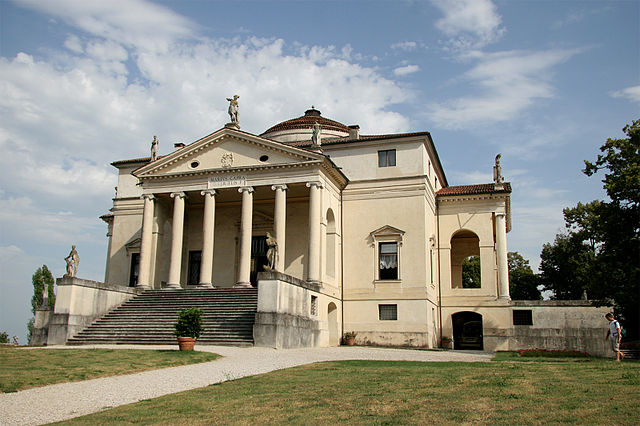Palladian architecture is a European architectural style derived from the work of the Venetian architect Andrea Palladio (1508–1580). What is today recognised as Palladian architecture evolved from his concepts of symmetry, perspective and the principles of formal classical architecture from ancient Greek and Roman traditions. In the 17th and 18th centuries, Palladio's interpretation of this classical architecture developed into the style known as Palladianism.
A villa with a superimposed portico, from Book IV of Palladio's I quattro libri dell'architettura, in an English translation published in London, 1736
Plan for Palladio's Villa La Rotonda (c. 1565) – features of the house were incorporated in numerous Palladian-style houses throughout Europe over the following centuries.
Villa Capra "La Rotonda" (begun c. 1565) – one of Palladio's most influential designs
Basilica Palladiana, Vicenza (from 1546) – loggia with Palladian windows
Classical architecture usually denotes architecture which is more or less consciously derived from the principles of Greek and Roman architecture of classical antiquity, or sometimes more specifically, from the works of the Roman architect Vitruvius. Different styles of classical architecture have arguably existed since the Carolingian Renaissance, and prominently since the Italian Renaissance. Although classical styles of architecture can vary greatly, they can in general all be said to draw on a common "vocabulary" of decorative and constructive elements. In much of the Western world, different classical architectural styles have dominated the history of architecture from the Renaissance until World War II. Classical architecture continues to inform many architects.
Caryatids on the Erechtheion, (Athens), an example of a Greek architectural element taken up by later classical architecture.
The fronts of ancient Roman temples like the Maison Carrée in Nîmes have inspired much later classical architecture, e.g. Virginia State Capitol.
Lorsch Abbey gatehouse (Germany), c. 800, an example of the architectural style of the short-lived Carolingian Renaissance, a first classical movement in architecture.
The emphatically classical church façade of Santa Maria Nova, Vicenza (1578–90) was designed by the influential Renaissance architect Andrea Palladio.








